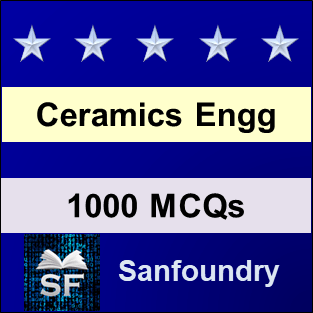Here are Ceramics Engineering MCQs (Chapterwise).
1. What are porcelain ceramics primarily composed of?
a) Silicon carbide
b) Feldspar and kaolin
c) Alumina
d) Boron nitride
View Answer
Explanation: Porcelain ceramics are predominantly made from feldspar and kaolin, which give porcelain its characteristic white color, translucency, and mechanical strength after firing. These materials are essential in producing high-quality tableware, electrical insulators, and dental prosthetics.
2. Which of the following is an example of hydrogen bonding in ceramics?
a) Cinnabar
b) Fluorspar
c) Silica
d) Kaolinite
View Answer
Explanation: Kaolinite is an example of hydrogen bonding. Hydrogen bonds can be formed between basal oxygen atoms in one plane and hydroxyl groups in another plane. Silica, fluorspar and cinnabar are other examples of ceramics not having hydrogen bonding.
3. Why are ceramics used in structural applications?
a) Due to low coefficient of thermal expansion
b) Due to high compressive strength
c) Due to low fracture toughness
d) Due to high strength to weight ratio
View Answer
Explanation: Ceramics tend to resist high temperatures. Therefore, they have low coefficient of thermal expansion. They are used in structural applications like buildings and bridges which require high thermal stability.
4. Electronegativity of zinc is 1.65 and that of oxygen is 3.44. What is the ionic character of zinc oxide?
a) 0.12
b) 0.82
c) 0.55
d) 0.34
View Answer
Explanation: By formula,
1-exp[ -0.25(Xm-Xx)2]
1-exp[ -0.25(3.44-1.65)2]
1-exp[ -0.25(1.79)2]
1-exp[ -0.801]
0.55
5. Bricks, tiles and sewer pipes fall under which category of ceramics?
a) Clay products
b) Refactories
c) Whitewares
d) Structural clay products
View Answer
Explanation: Structural clay products includes building bricks, tiles and sewer pipes. This category of ceramics involves applications where structural integrity is important. The whiteware ceramics become white after firing. Refactories are used in furnaces.
6. Which of the following is NOT a common method for forming ceramic products?
a) Electroplating
b) Injection molding
c) Extrusion
d) Isostatic pressing
View Answer
Explanation: Electroplating is not a common method for forming ceramic products. Common ceramic forming methods include extrusion (forcing clay through a die), injection molding (injecting ceramic material into a mold), and isostatic pressing (compressing ceramic powder in a flexible mold).
7. Why are most of the ceramics brittle?
a) Because of ionic bonding
b) Because of metallic bonding
c) Because of mixed ionic-covalent bonding
d) Because of covalent bonding
View Answer
Explanation: Ceramics contain mixed ionic-covalent bonds. The bonding of atoms in mixed ionic-covalent systems is much stronger than metallic bonding in metals. That is why, metals are ductile and ceramics are brittle.
8. Which of the primary raw material used in traditional ceramic production is:
a) Copper
b) Aluminum
c) Iron
d) Silica
View Answer
Explanation: Silica (silicon dioxide) is a primary raw material used in traditional ceramic production. It provides stability and strength to ceramic materials and is abundant in nature, making it widely used in pottery, bricks, and other ceramic products.
9. What is the coordination number of cations and anions in sodium chloride?
a) 12, 12
b) 8, 6
c) 6, 6
d) 6, 12
View Answer
Explanation: One sodium atom is surrounded by 6 other neighboring atoms therefore its coordination number is 6. Similarly, chlorine atom is surrounded by 6 other neighboring atoms giving coordination number 6.
10. Defects in ceramics do not occur alone.
a) False
b) True
View Answer
Explanation: To achieve electroneutrality in a system, defects in ceramics do not occur alone. For instance, in Frenkel defect, there is vacancy of a small ion from its original position and at the same time that ion occupies an interstitial position in the structure.
11. How does diffusion occur in ceramics?
a) Osmosis
b) Movement from lower concentration to higher concentration
c) Movement from higher concentration to lower concentration
d) Atomic defects moving through the crystal
View Answer
Explanation: Diffusion occurs by atomic defects moving through the crystal. Atomic diffusion rates are governed by defect types and their concentration. Concentration of defects increases with partial pressure of oxygen.
Chapterwise Multiple Choice Questions on Ceramics Engineering

- Ceramics Engineering Basics
- Bonds and Energy Bands
- Models, Crystals and Chemistry
- Complex Crystal and Glass Structures
- Point Defects, Charge and Diffusion
- Composites
1. MCQ on Ceramics Engineering Basics
The section contains multiple choice questions and answers on regarding the general properties of ceramics and their classification.
|
|
|
2. Bonds and Energy Bands
The section covers questions and answers on metallic bonding, mixed bonding, secondary bonding, ionic bonding, covalent bonding, and electron energy bands in ceramics.
|
|
|
3. Ceramics Engineering MCQ on Models, Crystals and Chemistry
The section contains MCQs on ceramics structure and pauling rules.
|
|
|
4. MCQ on Complex Crystal and Glass Structures
The section contains multiple choice questions and answers on perovskite, fullerenes and nanotubes.
|
|
|
5. Point Defects, Charge and Diffusion
The section covers questions and answers on ceramic defects, various types of point defects, and the mechanisms of diffusion.
|
|
|
6. Multiple Choice Questions on Composites
The section contains MCQs on spray pyrolysis.
|
|
Wish you the best in your endeavor to learn and master Ceramics Engineering!
If you find a mistake in question / option / answer, kindly take a screenshot and email to [email protected]
